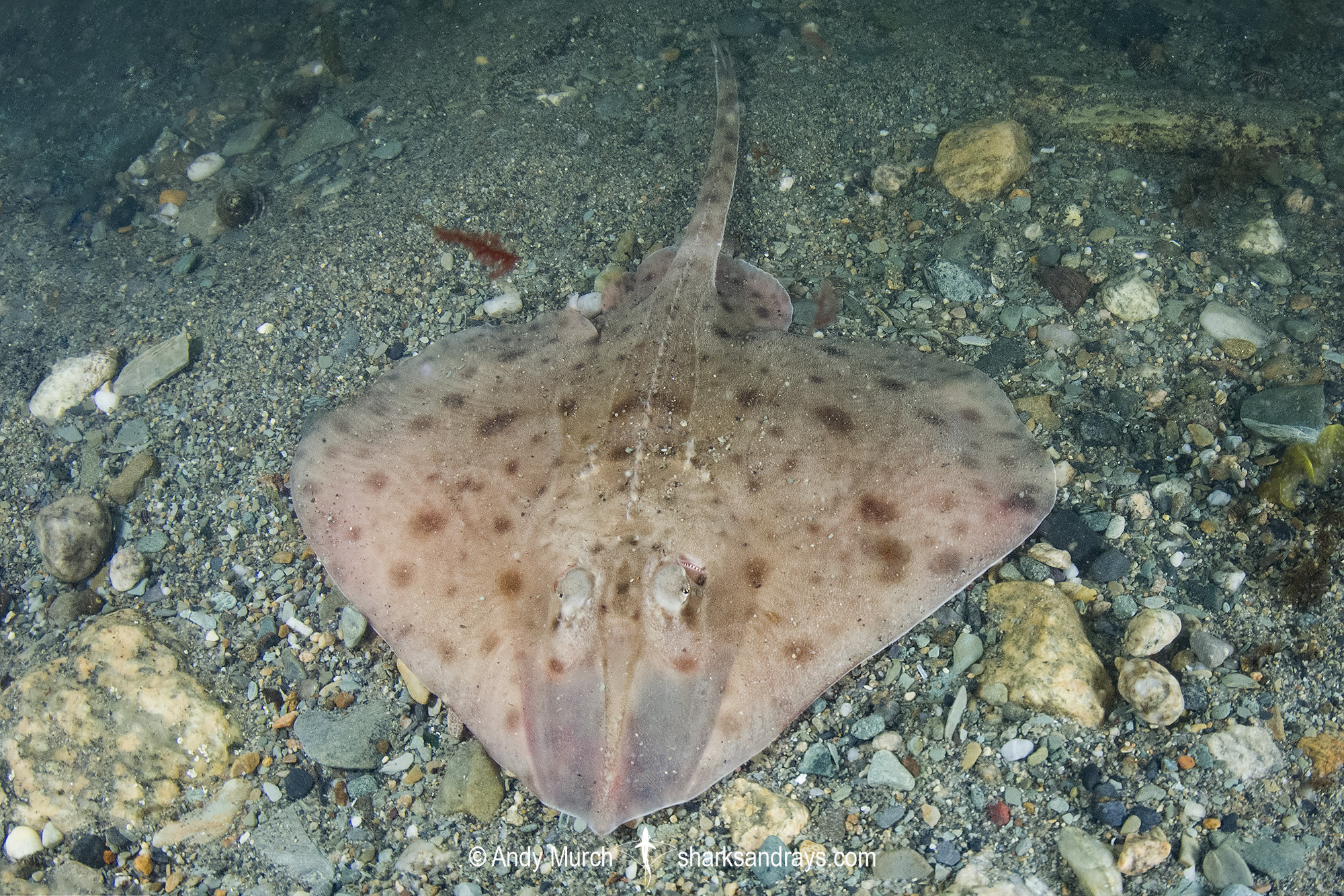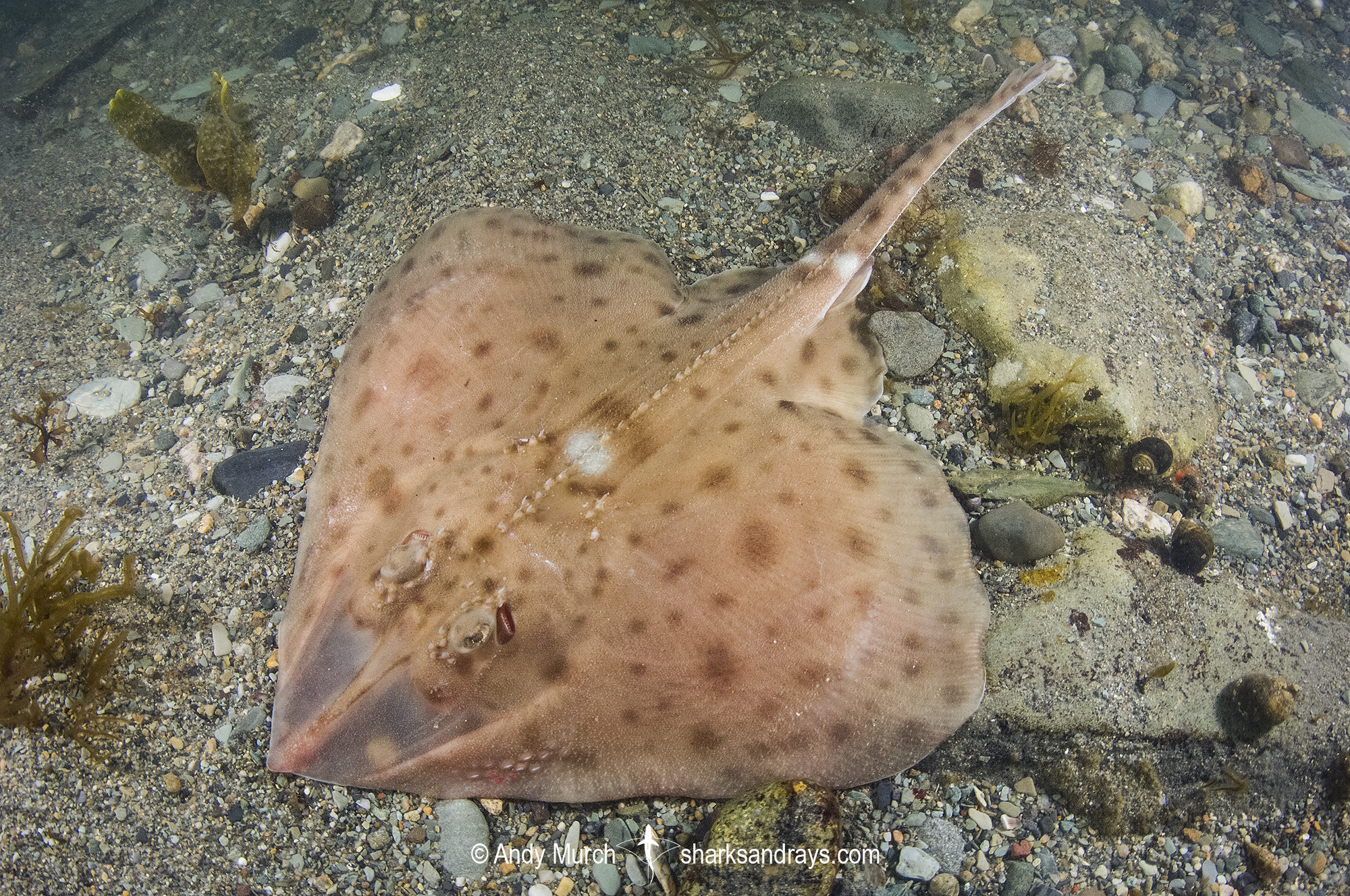Common name(s)
Smooth Skate.
Identification
A medium-sized skate with a heart-shaped disc. Disc width 1.2-1.3 x disc length. Snout moderately long with a right-angular or slightly obtusely angular tip. Snout length 3.4-3.6 x orbit length. Anterior margins of pectoral fins almost straight; weakly undulated in adult males. Pectoral apices broadly rounded. Disc appears velvety due to a dense covering of fine denticles. Thorns present on snout, around eyes, on shoulders, and in a single row along midline, decreasing in size posteriorly and absent from posterior half of tail. No lateral thorn rows on tail. Pelvic fins deeply notched. Anterior pelvic lobe well defined but much shorter than posterior lobe. Tail narrow. Dorsal fins confluent, low, with broadly rounded posterior margins. Caudal fin small.
Colour
Dorsum light brown or grey-brown, often with scattered diffuse darker brown spots on disc, tail, and dorsal fins. Single white ocellus edged by diffuse brown spots occasionally present on midline posterior to nape. 1-2 diffuse white or pale saddles often present near base of tail. Translucent rectangular areas adjacent to rostral cartilage appear darker than pigmented disc. Ventrum white, sometimes with dusky spots.
Size
Maximum length 71cm. Length at hatching 8-10cm.
Habitat
Cold-temperate seas. Demersal on continental shelf and deep slope, occasionally inshore. From 25-1435m. Mostly from 70-480m.
Distribution
Northwest Atlantic. The Smooth Skate occurs from New Jersey, USA to northern Labrador, Canada, including the Grand Banks, Southeast Shoal, and Flemish Cap. Sub-populations disjunct.
Conservation Status
VULNERABLE
The Smooth Skate (Malacoraja senta) is captured mainly in demersal trawl, longline, gillnet, and dredge fisheries. Historically, this species underwent very steep declines coinciding with high levels of demersal fishing from international fleets targeting shelf and slope groundfish. The extension of Exclusive Economic Zones out to 200 nautical miles in 1977 restricted fishing access to the USA and Canadian vessels. Effort was renewed on skates with the encouragement of directed skate fisheries as other groundfish fisheries collapsed in the USA and Canadian waters in the late 1980s and 1990s, and as international demand for skate wings increased. Population trends vary with latitude with very steep reductions in the northern (Newfoundland and Labrador Shelf, 2J3K) and central (Scotian Shelf and Bay of Fundy, Canada, 4VWX) parts of its range. There have been increases in the easternmost part of the range (Grand Banks, 3LNOPs) and signs of recovery in the southern part of is range in the USA. The overall index suggests a steep decline in abundance from the mid-1960s until the mid-1990s, followed by increasing abundance to the present day. The overall annual rate of decrease of 1.08% is consistent with an estimated median decline of 36.1% over three generation lengths (48 years), with the highest probability (62%) of >30% reduction over three generation lengths. Predation from recovering populations of Grey Seal (Halichoerus grypus) is estimated to have caused high levels of adult mortality in the Gulf of St Lawrence and which may be inhibiting recovery there. Overall, while the population trend is currently increasing, there have been substantial declines in the past and only limited recovery in some areas of its range. Mortality is ongoing from both bycatch and predation from Grey Seals in the Gulf of St Lawrence, and overall, this skate is estimated to have undergone a population reduction of 30–49% over the past three generations. Therefore, the Smooth Skate is assessed as Vulnerable (A2bd).
Citation
Kulka, D.W., Anderson, B., Cotton, C.F., Derrick, D., Pacoureau, N. & Dulvy, N.K. 2020. Malacoraja senta. The IUCN Red List of Threatened Species 2020: e.T161477A124492029. https://dx.doi.org/10.2305/IUCN.UK.2020-3.RLTS.T161477A124492029.en. Downloaded on 25 April 2021.
Reproduction
Oviparous. Females mature at 9.5-14.7yrs depending on location.
Diet
Juvenile smooth skates feed mostly on small crustaceans. Adults also consume bony fishes.
Behavior
Possibly moves in/offshore seasonally but the smooth skate does not appear to undergo long migrations.
Reaction to divers
Unknown but probably slow to react to divers.
Diving logistics
Although recorded as shallow as 25m, smooth skates are generally found below 70m and are very rarely encountered by divers. The most likely way to encounter this species is probably to search on mixed sand and gravel as close as possible to recreational limits in New England during the summer months.
What’s new
View our full list of updates
Similar species
Prickle Skate (Malacoraja spinacidermis) Similarly shaped but distinguishable by plain grey-brown dorsum and lack of thorns. Occurs deeper than 450m.







